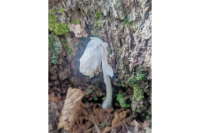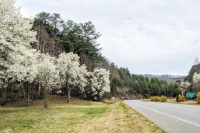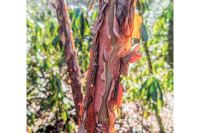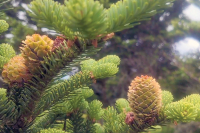Trying to preserve a national treasure
The U.S. Forest Service spent the first two weeks of November felling approximately 150 dead and/or dying eastern hemlocks in the Joyce Kilmer Memorial Forest adjacent to the Joyce Kilmer National Recreation Trail.
The hemlocks, many of them centuries old, had been ravaged by the hemlock woolly adelgid and were considered public safety hazards.
The hemlock woolly adelgid is an invasive exotic aphid-like insect that kills hemlocks by feeding on the sap at the base of the tree’s needles causing the needles to turn brown and fall off. With no needles (leaves) to provide nutrients, the tree ultimately starves to death. The hemlock woolly adelgid has nearly extirpated the eastern hemlock from the forested landscape of the Southern Appalachians.
The conundrum
The dead and dying hemlocks adjacent to the trail at Joyce Kilmer presented a danger to public safety and needed to be removed. However, Joyce Kilmer Memorial Forest is within the congressionally designated Joyce Kilmer-Slickrock Wilderness area, where mechanical equipment like chainsaws is prohibited.
But, according to Cheoah District Ranger Steve Lohr, there were other considerations as well.
Related Items
“One option would have been to close the area for three to five years and let nature take its course,” Lohr said. “But due to the popularity of the area, and its positive economic impact for Graham County, that wasn’t a practical solution.”
Approximately 35,000 people visit the area annually. Lohr said the dilemma was to come up with a plan that would ensure public safety while preserving the wilderness aspect of Joyce Kilmer.
The solution
The Forest Service came up with a novel (at least for eastern forests) solution. They decided to use dynamite to blast the dead hemlocks. Forest Service certified blasters attached explosives to trunks of the hemlock and then detonated them from a safe distance. Certified blaster Jon Hakala from Minnesota was the lead blaster.
Lohr said the trees could be felled with an amazing degree of accuracy and pointed to one stump where a dead hemlock had been taken out within feet of a living tree. The amount of explosive varied according to the size of the tree. Lohr said the hemlocks that were taken out at Joyce Kilmer took from 28 to 35 pounds of explosives. The largest hemlock felled had a diameter of 47 inches.
Aesthetics also played a big part in the decision to use dynamite. “Since this is a wilderness area, we wanted it to look as natural as possible,” Lohr said. “Smooth, sawn stumps just wouldn’t look right.” The dynamite blasts, however, leave a jagged, splintered stump that mimics natural windthrow.
Deputy District Ranger, Lauren Stull said that charges were set at different heights on the trunks to make it look like a wind or ice event had taken the trees out. On a tour of the site, Stull pointed to two nearly identical stumps about 10 feet apart. “The one on the left fell during a wind event on Oct. 25,” she said, “and the one on the right was blasted.”
Many of the felled hemlocks fell across the trail. Forest Service employees with crosscut saws (a primitive tool) cut the massive timbers out of the trail.
Logistics
The plan to take the hemlocks out had been in the works for a year or so. The Forest Service had to go through the NEPA (National Environmental Policy Act) process. Lohr said the service worked with local organizations like Partners of Joyce Kilmer and the Graham Revitalization Economic Action Team as well as national groups like the Wilderness Society. Stull said that the organizations supported the plan, realizing it was necessary for public safety.
The timing put off some bear hunters, but Stull said the service worked as quickly as possible to minimize the time the area was closed and that Forest Service staff were always on hand to ensure that no hunting dogs were in the vicinity during blasting.
Lohr said that because the area was used by the federally endangered Indiana bat, NEPA regulations prohibited blasting from April 1 through Oct. 15.
What the future holds
The stumps, logs and all the debris will be left as long as it’s not in the trail. Once again, the idea is to mimic natural gap creation in an old-growth forest. Lohr said he expected rhododendron, birch and poplar would begin to regenerate in the gaps but noted that there could be a lot of herbaceous understory prevalent in the immediate future. Stull also pointed out that small hemlocks were already present in the understory.
Candace Wyman, public affairs staff officer for the Forest Service was also present on the tour. She noted that the area with its “new” gap dynamics presents an ideal situation for area colleges and/or universities to conduct long term studies.
Stull noted that the service was in contact with Graham County schools about doing some hands-on learning for the local schools. Both Stull and Lohr said that the service was interested in monitoring the area but that no formal studies had been proposed or discussed at this point.
The Forest Service is extremely challenged in these times of rampant development and widespread invasive exotics to fulfill its mission of sustaining the health, diversity and productivity of America’s national forests.













